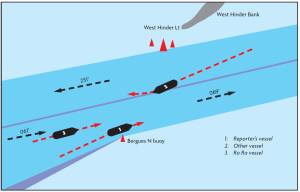The Charity
Aviation
Maritime
The perils in Traffic Separation Schemes

Initial Report
In the last edition we published two reports that showed how quickly things can go wrong in TSSs. One described an overtaking manoeuvre at dangerously close quarters; the other a head-on situation between ships crossing a TSS at a closing speed of about 35 knots.
To these we now add a third.
What did the reporter tell us?
The reporter’s ship, while heading NE in the Westhinder TSS, experienced a tight closest point of approach (CPA) with another ship in the opposite lane which veered slowly onto the separation line, before turning slowly back to his own lane. This happened while the reporter’s ship was being overtaken on his port side by a third ship with which the SW-bound ship placed herself for a period on a steady bearing.
Extracts from the information received by CHIRP
At approaches to Westhinder, ship 2 in the sketch was observed in the SW lane off Westhinder light tower. Own vessel was proceeding in the opposite direction in NE lane, passing close to Bergues North buoy, being overtaken by a ro-ro ship (ship 3 in the sketch) on port quarter. [ship 2] was then observed turning slowly to port and crossing the dividing line into the NE lane with a CPA of 3 cables to own vessel and collision course with [ship 3 in the reporter’s sketch]. I called on VHF 60, no answer … eventually [place] approach contacted ship 2 on VHF16 asking what were his intentions and that VHF 60 must be monitored … which then occurred, with [ship 2] turning back to starboard on the extreme edge of the separation scheme.
The reporter offered the view that ship 2 was not keeping a proper lookout, was not monitoring her position, and was in contravention of rule 10 (TSSs). She also failed to respond on the VTS channel for that sector and placed own vessel and another in a potentially dangerous situation. He noted that the standard of English was poor in VHF communication, that he (the reporter) was tightly constrained to starboard by the Bergues North buoy, and that visibility was good.

The lessons to be learnt
We do not in this case have the identity of or comment from the third party (ship 2); so the exact circumstances onboard are a matter of conjecture. The most probable explanation of this event is a loss of concentration on the bridge. It is also possible, but there is no evidence, that a technical failure may have contributed: of automatic steering, or the steering gear itself for example.
A highly dangerous situation arose; had ship 2 progressed any further before her alteration back to starboard into the south west lane, she would have been at very close quarters with ship 3, and quite possibly in collision. We see again how quickly such a situation can develop, especially in dense shipping and constrained waters. The danger is further exacerbated when the constriction of a TSS brings – in this case
– three large vessels into close proximity with almost no sea room to spare: the “sandwich effect”.
CHIRP Suggests
Traffic separation Collision Regulations (COLREGS). Ship 2 certainly contravened COLREG 10(b)ii (“… keep clear separation line”) by encroaching on the separation line, and at least came close to contravening COLREG 10(b)I (“… general direction of traffic”).
Traffic separation Collision Regulations (COLREGS). Ship 2 certainly contravened COLREG 10(b)ii (“… keep clear separation line”) by encroaching on the separation line, and at least came close to contravening COLREG 10(b)I (“… general direction of traffic”).
Other COLREGS. She also failed to take ‘positive action in ample time’, and was probably failing to keep a proper lookout. These failures may well have been exacerbated by overload, tiredness, distraction, undermanning, and/or failure to look up and out. Obviating these risks must be part of the passage planning process and supervision at the time.
Overtaking in a highly constrained part of a TSS or approaching a corner can be dangerous and reduces options. In this case the reporter’s ship had no room to starboard as she approached the Bergues North buoy. Look and think ahead.







